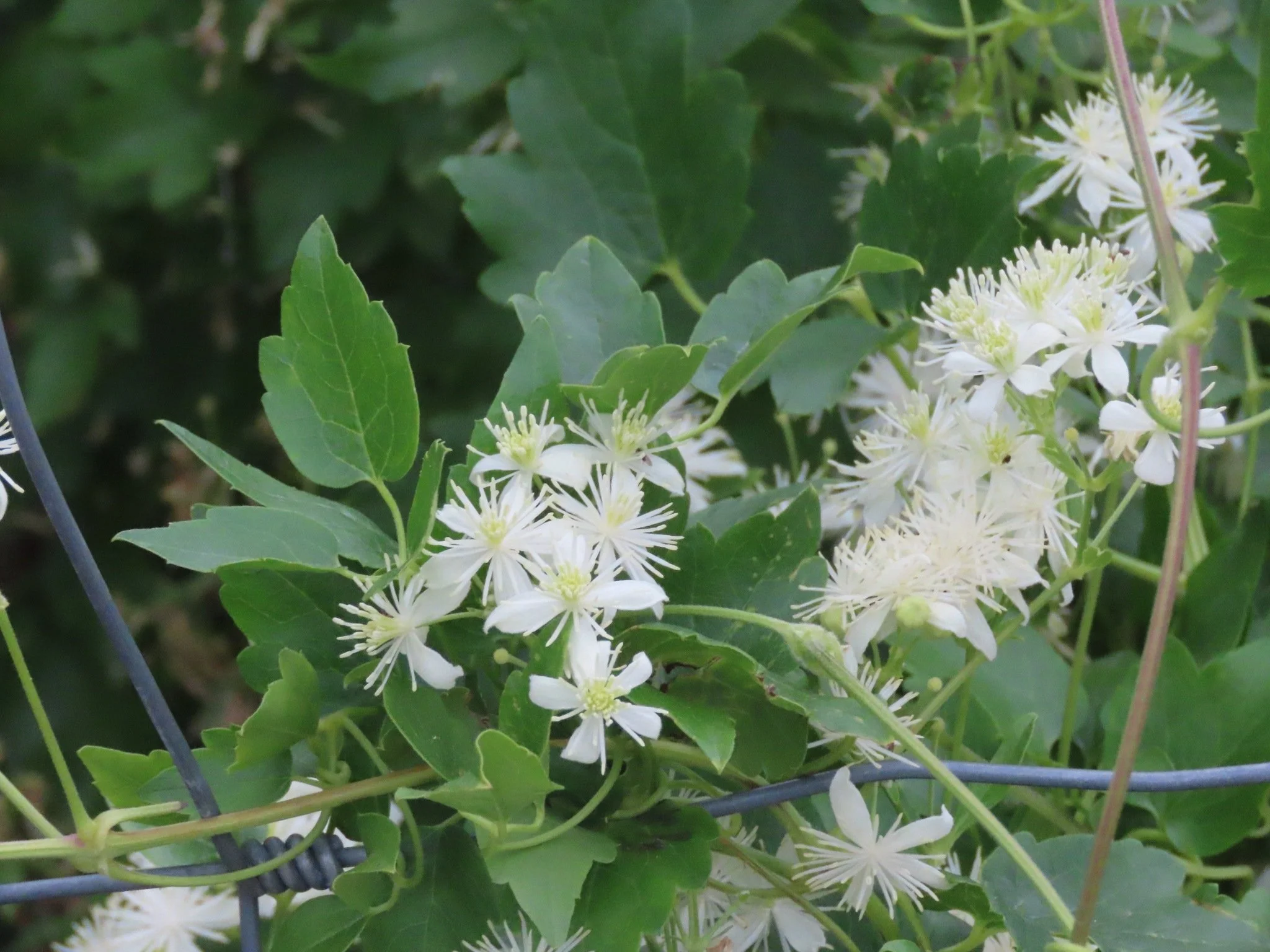Native Plant of the Month: Snowberry
Snowberry (Symphoricarpos albus var. laevigatus) is a hardy native shrub that brightens the landscape with clusters of white berries through the fall and winter months. Its pinkish flowers attract pollinators, while the berries feed birds and wildlife. Thriving in sun or shade, snowberry is a beautiful, low-maintenance choice for habitat restoration and native gardens alike.
Native Plant of the Month: Western White Clematis
Western white clematis (Clematis ligusticifolia) is a showy vining plant in the buttercup family, with creamy white flowers that bloom through the summer and leave beautiful fuzzy white seedheads in the fall. This creekside plant is adaptable, easy to care for, and provides food and shelter for wildlife.
Invasive Plant of the Month: Yellow Starthistle
Yellow star-thistle is an annual invasive plant that has spread across more than 15 million acres of land in California, and costs millions of dollars each year, especially in water loss. With the help of interns and dedicated volunteers, we’re managing this thorny invader and bringing back biodiversity.
Native Plant of the Month: Western Azalea
In late spring, the Western Azalea (Rhododendron occidentale) graces stream-side habitats throughout the Santa Cruz Mountains with beautiful white blooms and a fragrant aroma. This showcase shrub will thrive in wetter areas of your garden, providing seasonal interest and food for local pollinators.
Native Plant of the Month: Silver Bush Lupine
The silver bush lupine (Lupinus albifrons) is a striking shrub that offers year-long beauty to sunny, drought-tolerant gardens. With unique silver-green palmate leaves and stunning elongated purple flower clusters, this could be your new favorite native pollinator plant!
Native Plant of the Month: Sedges
Sedges may look like grasses, but they are in fact their own unique group of plants. Often found in wetlands or along streambanks, they can quickly stabilize soil by spreading through underground stems called rhizomes. This also makes them great for creating lush meadows or lawn replacements.
Native Plant of the Month: Pink-flowering Currant
Pink-flowering currant is a versatile native shrub that brings vibrant color and seasonal interest to gardens, offering stunning pink blooms in winter and edible berries in summer. Ideal for woodland settings, it thrives in a variety of soils and is easy to care for.
Native Plant of the Month: Redwood Sorrel
You’re walking around a shady redwood grove and notice a bed of shiny green clover-like plants covering the ground. This native plant is an important understory plant in redwood and Douglas fir forests that supports caterpillars, butterflies, and moths.
Plant of the Month: Stinkwort
Given the right conditions, non-native plants can outcompete and displace many of the California native plants that local insects and other animals depend on. Stinkwort is one of those weeds we’ve been successful in removing, thanks to Grassroots Ecology volunteers.
Plant of the Month: Teasel
One way to support California native habitat is to remove weeds that overcrowd our open spaces. Teasel is one of those weeds we've been successful in managing, thanks to Grassroots Ecology volunteers.
Native Plant of the Month: Wood Rose
Have you noticed the delicate, pink blooms of the wood rose within our local forest understories? This locally native rose is great for adding beauty and pollinator value to a shady garden or balcony.
Native Plant of the Month: Hairy Gumplant
Its sunflower-like blossoms face the sky like golden platters of pollen and nectar, which are constantly swarmed by minute sweat bees, fluttering skippers, and other insects.
Native Plant of the Month: Sticky Monkey Flower
The monkeyflowers are a diverse assemblage of plants, with flower colors ranging from golden yellow and pinkish purple to pale orange and bright red. Their ecological roles are equally varied, with each species having unique habitat preferences and pollinator interactions.
Native Plant of the Month: California Buckeye
California buckeyes are beginning to leaf out, starting yet another cycle of growth, blooming, fruiting, and dormancy for these beautiful native trees.
Native Plant of the Month: Scrub Oak
The California Scrub Oak (Quercus berberidifolia) is an under appreciated, compact oak species that provides huge habitat value while also fitting into smaller yards. California is home to over 20 species of oak. This includes the towering valley oak, which can grow up to 100 feet tall, as well as our ubiquitous and majestic coast live oak. But did you know we have a variety of small, shrub-like oaks as well?
Native Plant of the Month: Brittleleaf Manzanita
Brittleleaf manzanita (Arctostaphylos crustacea) is a stunning local shrub with smooth, red bark and upside-down urn-shaped flowers that attract pollinators in winter. This fire-adapted species is unique to chaparral ecosystems of the central California coast and makes a beautiful focal plant in the garden.
Native Plant of the Month: Coast Silktassel
Coast silktassel (Garrya elliptica) is a shrub to small tree adorned with enchanting catkins of gray flowers in the winter. These attractive, drought-tolerant plants are popular with gardeners who want to add an element of whimsy to their landscapes.
Native Plant of the Month: Coffeeberry
Coffeeberry (Frangula californica) is the native plant gardener’s best friend, and a constant companion to our local oaks! Though its understated appearance might not grab your attention right away, the coffeeberry’s subtle elegance, forgiving nature, and high value to pollinators will be sure to win you over.
Native Plant of the Month: Bushmallow
Bushmallows are a diverse and underappreciated group of shrubs with stunning, pink blooms and soft, fuzzy leaves. Our local arcuate bushmallow (Malacothamnus arcuatus var. arcuatus) is only found in the Santa Cruz mountains and is a great option for sunny spots in the garden.
Native Plant of the Month: California Native Bunchgrasses
California bunchgrasses provide beauty and habitat long after invasive annual grasses have died off, and their deep roots make them drought-tolerant and great for increasing soil health and carbon storage. Now there’s some grassroots power!




















